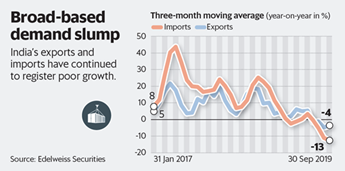

Exports during this fiscal have fallen 2.5% to $159.6 billion, especially labour-intensive exports. It is important to access the foreign trade situation in India, especially in the backdrop of slowdown in the economy.
Context
Exports during this fiscal have fallen 2.5% to $159.6 billion, especially labour-intensive exports. It is important to access the foreign trade situation in India, especially in the backdrop of slowdown in the economy.
About
- One of the leading matters of concern for India’s macroeconomic performance is declining exports.
- September 2019 trade deficit was at a seven-month low as exports declined 6.5%. Exports, imports witness the steepest fall in three years

- Labour-intensive exports (like agriculture and allied products, leather and leather products), which create employment in large numbers, have been falling.
- Exports from textiles and ready-made garment sectors can help a country’s transition from “developing" to “developed"—all the more so because they create employment for women.
- While textile/ready-made garment exports haven’t been performing adequately, labour force participation rate of women has fallen dramatically over the years.
- India's merchandise exports have also registered a fall.
- Engineering goods are by far India’s largest exports. While engineering good exports have fallen, electronic goods exports have increased (42.3%).
- Lately the trade balance improved slightly, but it’s mostly because of falling imports rather than growing exports.
- World Bank in its World Development Report (WDR) 2020 estimated that the share of intermediate goods in global merchandise trade was as high as 50%. But India’s access to Global Value Chains (GVCs)—about 16%- is not enough.
- Five Indian states — Maharashtra, Gujarat, Karnataka, Tamil Nadu and Telangana — accounted for 70% of India's total exports in FY 2018.
|
Trms related to the external sector:
|
Causes for declining exports
- Structural factors like low technological adaptability, and absence of technology intensive foreign investment, are curtailing India’s exports.
- The slowdown of engineering goods is the result of such structural factors.
- Undervalued currency policies adopted by competitors (like China) amidst relatively strong rupee, makes it difficult to retain export competitiveness.
- In the context of rising anti-globalization sentiments in the West, countries are adopting micro policies to limit their imports.
- Trade is now intensively conducted through Regional Trade Blocs or FTAs where countries exchange trade benefits on mutual understanding. This has led to discrimination against countries like India which are not members of any powerful trade blocs.
- Export of India depends upon income in other countries. Slow economic growth in rest of the world also reduces India’s exports.
- The implementation and refund delays under GST may have also caused working capital constraints for firms, which in turn might have hurt their exports.
- There is limited diversification of India’s export basket, with the top 10 principal commodity exports accounting for as much as 78 per cent of total merchandise exports.
Consequences of declining exports
- Trade deficit worsens as export income decreases and import costs increase. A $671 million trade deficit in FY01 swelled to $63 billion in FY18.
- With shrinking trade deficit, India’s slowdown battle has got prolonged.
- India imports the bulk of the fuel it consumes in various forms. A weaker rupee makes petrol and diesel expensive. Governments also earn a lot of taxes from petrol and diesel and are not in a position to cut these taxes. It’s really a choice between stronger labour-intensive exports and cheaper petrol and diesel.
- Though India has benefitted from the import of cheap intermediate and capital goods from China. However, the rising trade deficit with China is unsustainable.
- When market conditions for principle export commodities worsen, it has a major impact on overall export performance. For example, four of India’s lead exports (Engineering goods, Gems and jewellery, chemicals and readymade garments) registered negative or near zero growth rates during 2015-16.
How exports can be revived?
- A weaker rupee would help Indian exporters compete on the price front by helping them earn more in rupee terms—thus allowing them to cut prices to stay competitive
- Government is coming up with Foreign Trade Policy 2020-25. If norms for import of raw materials and capital goods for exporters are relaxed, it can be a boost for exports.
- Higher export rewards to products with geographic indication (GI) tag such will add teeth to the Make in India scheme, and boost exports.
- Rationalising government schemes to encourage more local sourcing of inputs of export products.
- There is a high correlation between a state's Gross State Domestic Product (GSDP) per capita and its share of total exports. Measures to boost GSDP will also help revive exports.
- RCEP can be used as an opportunity to add value in GVCs. A single percentage point increase in GVC boosts per capita income levels by more than 1%, and more than 0.2% income gain from standard trade. Benefits of GVC go a long way:
- Helped poor countries grow faster
- Create new jobs, reduce poverty and inequality
- All these can have long term consequences in improving trade
- Improving access to credit and reducing cost of credit, especially for merchant exporters.
- Interest equalization support to all agricultural exports.
- Increasing budgetary support for marketing and exports related infrastructure.
- Creating a single point interface for customs clearance of import and export goods.
- Simplifying various export incentive schemes:
- Advance Authorisation Scheme (AAS)
- Export Promotion Capital Goods (EPCG)
- Service Exports from India Scheme (SEIS)
- Merchandise Exports from India Scheme (MEIS)


